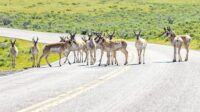Wildlife Conservation Success Stories – In a time marked by environmental challenges, the importance of wildlife conservation has never been more evident. Across the world, countless species face threats from habitat destruction, pollution, illegal trade and climate change. Yet in the midst of these threats, there are beacons of hope – success stories of species that have recovered, thanks to concerted conservation efforts. These stories not only inspire, but also highlight effective strategies and the critical role of community engagement in wildlife conservation.
The role of conservation efforts: Conservation efforts encompass a variety of strategies tailored to the needs of different species and ecosystems. These include breeding programs that aim to increase population numbers, legal protections that protect animals and their habitats, and habitat restoration projects that help rebuild environments that are critical to the survival of species. Community involvement is critical, as local and indigenous groups often bring invaluable knowledge and a vested interest in the health of their natural resources.
Wildlife Conservation Success Stories

American Bison: Once numbering in the millions, the American bison was nearly exterminated in the late 19th century due to overhunting and the expansion of agriculture. Conservation efforts began in earnest in the early 20th century, with the establishment of national parks and wildlife sanctuaries that served as sanctuaries. Today, thanks to robust legal protections and managed breeding programs, bison populations have recovered to more than 500,000 individuals on public and private lands in North America.
The Esa Is 50 Years Old—here Are 50 Species That Are Recovering
The bald eagle: The bald eagle, the national bird of the United States, faced alarming declines in the mid-20th century due to widespread use of the pesticide DDT, hunting and habitat loss. The ban of DDT in 1972, combined with greater legal protection and dedicated recovery programs, facilitated a dramatic comeback. Today, shellfish numbers have increased to more than 71,400 breeding pairs, a testament to the effectiveness of persistent conservation and pesticide management efforts.
Mountain gorilla: Inhabiting the rugged terrain of Central Africa’s Virunga volcanoes, the mountain gorilla’s existence has been threatened by poaching, civil conflict and habitat encroachment. Through international cooperation, conservation-focused programs, including anti-poaching patrols, veterinary care and community conservation projects, have gradually increased in number. From a low of 254 in 1981, the population has grown to more than 1,000 individuals, moving them from the brink of extinction to a path of hopeful recovery.
Giant panda: A global symbol of wildlife conservation, the giant panda has seen its fate turn from dire to hopeful. In China, extensive habitat conservation and reforestation efforts have been accompanied by a successful breeding program. These initiatives helped increase its population in the wild, leading to the giant panda being downgraded from “threatened” to “vulnerable” on the IUCN Red List in 2016. Today, there are more than 1,800 pandas living in the wild and in captivity. .
How conservation affects ecosystems: Protecting a single species can have cascading effects across an ecosystem. For example, conserving top predators such as the gray wolf can regulate deer populations, which in turn helps maintain the health of vegetation and forest structures. These efforts can also strengthen local economies through ecotourism, providing communities with sustainable sources of income.
Back From The Brink Of Extinction: The Best Conservation Success Stories
How readers can contribute: Every individual can play a role in supporting wildlife conservation. Consider donating to organizations that directly impact conservation efforts or get involved in local and global advocacy to promote policies that protect the environment. Simple actions like reducing waste, limiting single-use plastics and spreading conservation awareness can together lead to significant change.
Conclusion: The wildlife conservation journey is fraught with challenges, but the success stories of species like the giant panda and mountain gorilla remind us of the resilience of nature and the impact of human management. By supporting conservation initiatives and making environmentally conscious decisions, we can all contribute to a healthier planet and sustainable coexistence with the world’s wildlife. Chris Servheen and Doug Smith, both prominent scientific experts, say carnivore management in western states and Congress threatens the recovery of wolves and grizzly bears.
The photo is a composite of a Yellowstone wolf and a Yellowstone grizzly bear. Images courtesy of NPS. Composite photo credit:

EDITOR’S NOTE: If you are a citizen who values professional management of public wildlife and believes that science and the public trust doctrine should guide decision-making, then you will be hard-pressed to find two people more knowledgeable about grizzly bears and wolves than than Dr. Christopher Servheen and Dr. Douglas Smith. Together, they have nearly 85 years of field and high-level experience promoting the conservation of Greater Yellowstone’s two most iconic species and animals, closely identified with what we used to call the true Wild West.
Wildlife Success Stories · National Parks Conservation Association
For four decades, Servheen has been involved in the recovery of the fortunes of grizzly bears in the Northern Rockies, 35 of those years as the national grizzly bear recovery coordinator for the U.S. Fish and Wildlife Service. Around the same time, Smith was involved in wolf management in the upper Midwest and later became chief wolf researcher in Yellowstone National Park. Today, both are retired from government service and can speak more openly about the state of both species and what trend lines indicate for their future. The recovery of grizzly bears and wolves has been hailed as two of the largest wildlife recoveries in conservation history. In this essay written for
, they share their thoughts below. Note: We will be hosting these two highly regarded big-picture thinkers at two events in Bozeman and Missoula in October. —Todd Wilkinson,
Anyone concerned about our native wildlife should be concerned that in Congress and in the states of Montana, Idaho and Wyoming, politics,
, drives carnivore management decisions that have produced regressive policies and legislation that are both anti-carnivore and anti-scientific.
Saving The Endangered Animals Of India A Race Against Time
Current wildlife management in the US is respected for its global leadership and application of science-based conservation. This is a change from previous practices of the 1800s and early 1900s, which allowed excessive and unregulated killing of wild animals, with dramatic declines in the populations of many species such as bison, elk and pronghorn, almost complete extirpation of wolves in the Lower 48 states, local extinction of fishermen and wolverines, and near extinction of grizzly bears.
Modern wildlife management has corrected these problems by introducing regulated harvest and hunting management as a valuable resource and has largely eliminated the unrestricted and indiscriminate killing of wildlife. Science-based management to restore most big game species, including carnivores, and the Endangered Species Act (ESA) have allowed many wild species to make a huge comeback.
The success of wildlife restoration in the United States has been a model for the world. But now, recent congressional laws overturning Endangered Species Act requirements and Montana, Idaho and Wyoming predator zone laws aimed at reducing wolves are taking us back to the regressive years of the late 1800s. These laws are contrary to professional wildlife management ethics and science-based wildlife management.

The American public appreciates the value of wildlife and more than 148 million Americans are engaged in non-consumerist wildlife viewing. As pressures on human population and habitat development increase, we must work together to improve our management of wildlife in the 21st century, rather than reverting to anti-predator policies of the past that we know are destructive. State wildlife management policies should serve the majority of the public and not be driven by a small, predator-hating minority.
Little Known Wildlife Conservation Success Stories
Anti-meat legislation in Idaho, Montana and Wyoming raises significant concerns. The Idaho Legislature has directed state agencies to implement new, intensive and lethal methods to reduce wolf numbers across the state. These legislative actions could reduce wolf numbers to 150 – the minimum number required by the federal government for recovery – and potentially kill 90% of Idaho’s estimated 1,500 wolves. In Montana, state lawmakers have passed new laws and new wolf-killing methods to try to reduce the state’s wolf population from about 1,200 wolves to 450 or fewer. Wyoming has classified wolves as “predators” in most of the state, where they can currently be killed by any method year-round without a license. It is legal to run over wolves (and coyotes) with motor vehicles in the Wyoming Predator Range, even on public lands (see article by author Todd Wilkinson, April 2024). It is currently legal to shoot most predators with snow machines in Montana and Idaho.
Wolves have always been a particular management challenge, with social carrying capacity often taking precedence over biological carrying capacity or even long-term sustainability. Due to their high reproductive rate and resulting resistance to human mortality, the management response has always been high rates of harvest (sometimes exceeding sustainability) and/or control (elimination of 80 to 90 percent of the population in a given area). .
The graphic above shows Wyoming’s “Wolf Trophy Game Management Area,” which covers about 15% of the state. Wolf hunting is not permitted in Yellowstone and Grand Teton National Parks. Beyond the northwest corner of Wyoming, wolves are not treated as a game species, but are relegated to a lower status as carnivores. There, in the “predator range” that covers 85% of the state, they can be legally killed 365 days a year, at any time, on any day, by almost any means. Never in the history of endangered species,
- Marine Turtle Conservation: Protecting Endangered Turtles 2024 - September 8, 2024
- Dog Care Advice For Busy Families - August 24, 2024
- Wildlife Conservation Funding - August 23, 2024







